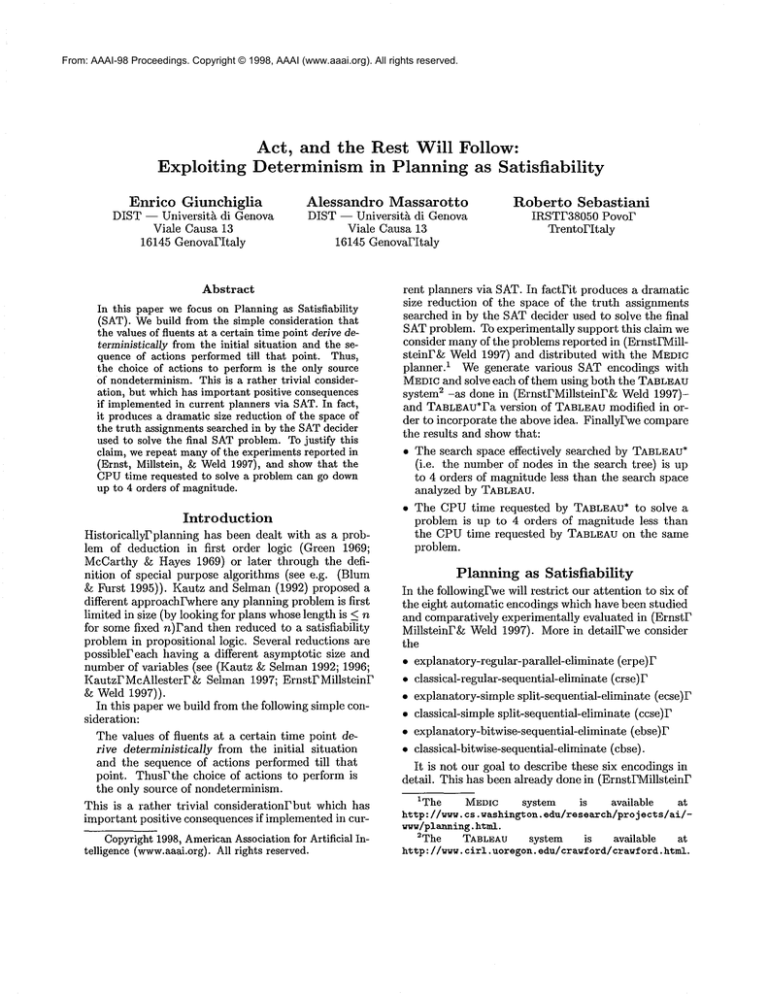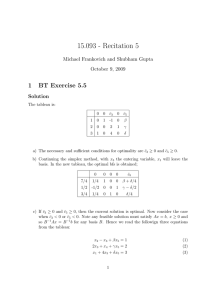
From: AAAI-98 Proceedings. Copyright © 1998, AAAI (www.aaai.org). All rights reserved.
Exploiting
Act, and the Rest Will
Determinism in Planning
Enrico Giunchiglia
DIST -- Universit~ di Geneva
Viale Causa 13
16145 GenovaFItaly
Alessandro
Follow:
as Satisfiability
Massarotto
DIST -- Universit~ di Geneva
Viale Cansa 13
16145 GenovaFItaly
Abstract
In this paper we focus on Planning as Satisfiability
(SAT). Webuild from the simple consideration that
the values of fluents at a certain time point derive deterministically from the initial situation and the sequence of actions performed till that point. Thus,
the choice of actions to perform is the only source
of nondeterminism. This is a rather trivial consideration, but which has important positive consequences
if implemented in current planners via SAT. In fact,
it produces a dramatic size reduction of the space of
the truth assignments searched in by the SATdecider
used to solve the final SATproblem. To justify this
claim, we repeat manyof the experiments reported in
(Ernst, Millstein, ~ Weld 1997), and show that the
CPUtime requested to solve a problem can go down
up to 4 orders of magnitude.
Introduction
HistoricallyFplanning
has been dealt with as a problem of deduction in first order logic (Green 1969;
McCarthy & Hayes 1969) or later through the definition of special purpose algorithms (see e.g. (Blum
& Furst 1995)). Kautz and Selman (1992) proposed
different approachFwhere any planning problem is first
limited in size (by looking for plans whose length is <
for some fixed n)Fand then reduced to a satisfiability
problem in propositional logic. Several reductions are
possibleFeach having a different asymptotic size and
number of variables (see (Kautz & Selman 1992; 1996;
KautzFMcAllesterF& Selman 1997; ErnstFMillsteinF
Weld 1997)).
In this paper we build from the following simple consideration:
The values of fiuents at a certain time point derive deterministJcally
from the initial situation
and the sequence of actions performed till that
point. ThusFthe choice of actions to perform is
the only source of nondeterminism.
This is a rather trivial considerationFbut
which has
important positive consequences if implemented in curCopyright 1998, AmericanAssociation for Artificial
telligence (www.aaai.org). All rights reserved.
In-
Roberto Sebastiani
IRSTF38050 PovoF
TrentoFItaly
rent planners via SAT. In factPit produces a dramatic
size reduction of the space of the truth assignments
searched in by the SATdecider used to solve the final
SAT problem. To experimentally support this claim we
consider many of the problems reported in (ErnstFMillsteinF& Weld 1997) and distributed
with the MEDIC
planner. 1 We generate various SAT encodings with
MEDICand solve each of them using both the TABLEAU
system 2 -as done in (ErnstFMillsteinF&
Weld 1997)and TABLEAU*Faversion of TABLEAU
modified in order to incorporate the above idea. FinallyFwe compare
the results and show that:
¯ The search space effectively
searched by TABLEAU*
(i.e. the number of nodes in the search tree) is
to 4 orders of magnitude less than the search space
analyzed by TABLEAU.
¯ The CPU time requested
by TABLEAU*to solve a
problem is up to 4 orders of magnitude less than
the CPU time requested
by TABLEAUon the same
problem.
Planning as Satisfiability
In the followingPwe will restrict our attention to six of
the eight automatic encodings which have been studied
and comparatively experimentally evaluated in (ErnstF
MillsteinF& Weld 1997). More in detailFwe consider
the
¯ explanatory-regular-parallel-eliminate
¯ classical-regular-sequential-eliminate
(erpe)F
(crse)F
¯ explanatory-simple split-sequential-eliminate
(ecse)F
¯ classical-simple split-sequential-eliminate
(ccse)F
¯ explanatory-bitwise-sequential-eliminate
¯ classical-bitwise-sequential-eliminate
(ebse)F
(cbse).
It is not our goal to describe these six encodings in
detail. This has been already done in (ErnstFMillsteinF
1The
MEDIC system
is
available
at
http://www.cs.washin~on,
edu/research/proj
ects/ai/www/planning,
html.
2The
TABLEAU system
is
available
at
http://www,
cirl.uoregon,
edu/crawford/crawf
ord.html.
INITIAL
GOAL
///////////////////////////////
T
Move(b, s, d)
PRECOND:
EFFECT :
Block(b) A Clear(b) A On(b, s)A
(Clear(d) V Table(d))A
bCsAbCdAsCd
Clear(s) A -~On(b, s)A
On(b, d) A -7 Clear(d)
Figure 1: A Blocks WorldPInitial
and Goal States
& Weld 1997). Wewill recall the underlying ideas and
illustrate
them through the simple blocks reverse problem in Figure 1. This planning problem is characterized by the single operator MoveP4individuals (the
blocks AFBFCand the table T)Pinitial and goal states
as in the Figure.
We will use the same notation and terminology employed in (ErnstPMillsteinF&
Weld 1997). ThusFtime
takes nonnegative integer valuesPfluents occur at even
time pointsF and actions occur at odd time points.
We represent the fluent e.g. On(A, B) at time t by
Ont(A, B)Pand the action e.g. Move(A, B, C) at time
t by Move~(A, B, C). Notice the index r to actions: it
indicates it is a representation which varies according
to the particular encoding used.
Before illustrating
the various encodingsPwe recall
thatPfor any given planning problem and plan length
n > 0Fthe clauses corresponding to the following facts
always belong to the final SATproblem:
¯ For any actionFif it is executed at time 0 < t < 2n
then its preconditions and its effects must be satisfied at time t - 1 and at time t + 1 respectively. For
examplePfor the action Move~(A, B, C) we will have
(action axioms)
Move~(A, B, C)
Cleart-1 (A) A Ont-1 (A, B) Cleart-1 (C)A
Cleart+l (B) A -~ Ont+l (A, B)A
Ont+l (A, C) A ~ Cleart+l (C).
¯ At time 0 the formula specifying the initial
state
must be satisfied. In our exampleFall the fluents are
assumed to be false at time 0 except for
Ono(A, B), Ono(B, C), Ono(C, T), Clearo(A).
¯ At time 2n the formula specifying
must be satisfied:
the goal states
On2r~(C, B) A On2n(B, A) A On2n(A,
FinallyF we always employ the optimizations
described in (ErnstFMillsteinF& Weld 1997) and implemented in the MEDICplannerFsuch as factoring
and
type optimizations.
These allow to reduce the number
of actions (e.g. the actions in which b is not a blockF
or in which b = s or b = d or s = d are not generated)F
the number of fluents (e.g. fluents like Table(A) are
automatically considered to be false at each even time
step)Fand the size of the encodings.
The encodings differ for the "Frame axioms representation" (Classical/Explanatory)F
"Action representation" (Regular/Simple-split/Bitwise)
F"Planning strategy" (Sequential/Parallel).
Frame axioms
representation
Classical (McCarthy & Hayes 1969): any action specifies that the non affected fluents keep their values.
For exampleFmoving A from B to T does not affect
whether block C is clear or not:
Move~(A, B, T) Cleart_~ (C ) D Cleart+l (C
Move~(A, B, T) A -~ Cleart_ 1 (C) D --, Cleart+l
"At-least-one-action"
axioms guarantee that at each
odd time step some action occursPthus preventing
fluents from changing freely due to non-action:
V
b,s, d c {A,B,C,T}
b~s,b~d,s¢d,b¢T
Move~"(b, s, d).
Explanatory (Haas 1987): If a fluent changes its
valueFsome action affecting it must have occurred.
For exampleFif block C becomes unclear[then either
we have moved A or B on top of C:
’, Cleart +l ( C) A Cleart- l ( C)
Move~(A, B, C) V Move~(A, C)V
Move~(B, A, C) V Move~(B, T,
Action
representation
Regular : each action is represented
by a distinct
variableFe.g. Move[ ( A, B, C) is Mover(A, B, C). In
our example there are 18 actions and thus we will
have 18 variables per odd time step.
Simple-split:
each n-ary action is replaced
by
the conjunction
of n distinct
variablesF
e.g.
Move~(A, B, C) is
MoveArglt (A) A MoveArg2t (B) A MoveArg3t (C).
In our example we will have 11 variables
time step.
per odd
Bitwise : each action corresponds to a conjunction of
[log2‘4] literalsFwhere ,4 is the number of actions.
The conjunction corresponds to a sequence of bits
numbering the set of action. In our example 5 bits
are sufficient.
If we number the set of actions according to the lexicographic orderP Move~(A, B, C)
is
--~Bitl t A -~Bit2t A -~Bit3t A --~Bit4t A -~Bit5t.
Planning Strategy
Sequential : for each pair of actions a and flFadd
axioms of the form ~a[ V -~fl~ for each odd time
step. For exampleFwewill have:
-~Move~
( A, B, C) V -~Move~( A, B,
These axioms ensure that at each time step at most
one action is executed. They are not included (since
not necessary) for encodings using a bitwise action
representation (i.e. ebse and cbse) or the classical
frame axioms(i.e. crseFccse and cbse).
Parallel : for each pair of actions a and flFadd axioms
of the form -~a~ V -~fl~ for each odd time step if a
effects contradict/3 preconditions. For exampleFwe
will have
-~Move~(B,T, A) V -~Move~(A,B,
These axioms do not prohibit to execute more than
one action at some time stepF and the result is a
plan whose actions form a partial order. HoweverF
imposing any total order compatible with the partial
order constitutes a valid plan.
Act, and the rest will follow
In the next two sectionsFwe will use the symbol L to
denote a literal; the symbolA~to denote the i-th action
variable at time t; the symbolF] to denote the j-th fluent variable at time t; the symbolsAt and Ft to denote
respectively the sets of action variables {AtlFAt2F... }
and fluent variables {FtlIF2F... ) at time t; the expressions preconds(A~)and effects(A~) to denote the sets of
precondition and effect variables respectively of action
A~. Wedenote with .4 and ~" the cardinality of At and
let respectively (which do not depend on t)Dand with
n the length of the searched plan.
The work underlying this paper starts from observing thatFindependently from the encoding usedFthe
following simple facts hold:
1. for each tFthe truth values of the fluent variables in
F~ derive deterministically from the initial values F0
and from the truth values of the action variables in
AID.. FA~-ilh’epresenting all the actions performed
before t. Thus:
2. the choice of the truth values for the action variables
A~’s is the only source of non-determinism in SATencoded planning.
These facts translate into SAT-encodedplanning the
consideration about determinism in the introductory
section.
ConsiderFfor instanceFthe regular representation of
actions and the classical frame axioms. For each odd
time tFif all the fluent variables FtJ_i have been assigned a truth value and one action variable A~ has
been assigned trueFthen all the fluent variables Ft~+i
which are in effects(A~) can be deterministically assigned as a consequence of the action axiomsFwhile
DP(r, U)
if 0 E F then return;
if F -- ~ then exit with a modelof U;
UNIT-PROPAGATE (F,
U);
L :--- a literal such that L or -~Loccurs in F;
DP(F U {L}, U);
DP(DU {-~L}, V);
UNIT-PROPAGATE(F,
U)
while there is a unit clause {L}in F
U :-- U U {L};
for every clause C E F
ifLECthenP:=P\{C}
else if-~L E C then
F := F \ {C} U {C \ {~n}}
end for
end while
Figure 2: The Davis-Putnam procedure
all the other fluent variables Ftk+l can be assigned as
a consequence of the frame axioms. Notice that the
reverse is not trueFthat isFthe values of actions A~’s
are not a deterministic consequenceof the values of the
variables in Ft-i and in Ft+i.
Current SAT-basedplanners do not take advantage
of these issues. In factDthe SATdecider run over the
SAT-encodedproblem - typically a local search engine like WalkSAT
(Kautz ~ Selman 1996) or a DavisPutnam implementation like TABLEAU
(ErnstF MillsteinF~ Weld 1997) - performs a search on the whole
spectrum of encoded variablesFbranching on both action and fluent variablesF without distinction. As a
consequenceFitsearches in a space of truth assignments
of size 2(A+~:)’nFwhileFact 2. suggests a size bound
of A’n.
2
Exploiting
determinism
on fluent
values
Consider the standard Davis-Putnam procedure described in Figure 2. IntuitivelyFat each step DPperforms first all the deterministic assignments by invoking UNIT-PROPAGATE; then it performs a nondeterministic step by choosing a literal LFandrecurses
sequentially with L -- true and L = false. L can be
both an action or a fluent literal.
Fact 2. in the previous section suggests that in SATbased Planning the search should be restricted to find
values to action variables onlyFas the values for fluent
variables can be eventually obtained for free. To this
extentFwe introduce DP*Fwhichis obtained from DP
by substituting the literal choice step with the following:
L :-- an action literal such that L or -~L occurs in F;
that isFweforce DP*to select only action literals like
A~ or ~A~in the non-deterministic step.
DP*terminates for every encoding usedFas all fluent variables are assigned deterministically by UNITPROPAGATE.
The idea is that all encodings create
clauses with at most two fluent variablesFof the form
F]_I IF]+1. If no more action variables occur in FFthen
only unit clauses like (F]_I) and (-,F[_I) and binary
clauses like (~F]_1 V FtJ+l) and (F]_1 V~F]+
1) are left
overFwhich are all solved by UNIT-PROPAGATEI~from
(Fd)’s and (-~Fd)’s onward.
For examplePassumethat the regular representation
of actions and the classical frame axioms have been
used. For each action variable A~Pthe SATencoding
contains the following clauses:
Regular action representation:
A
(-,A~ V L)
(1)
L 6 preconds(A~)
A (~A~
(2)
V L)
L 6 effects(A~)
Classical
frame axioms:
v
A
(3)
F/+, ¯ Ft+l/leffects(A~)l
A
(--,A~
V F~_I
V mFtJ+l ) (4)
F/+~¯ Ft+l/l~ffea~(A~)l
wherele:.fects(ADl
denotes the set of F/+z’s s.t. either F:+1 ¯ effects(A~) o1" -~F]+
1 ¯ effects(A~).
At-least-one
axiom:
V A~
A~ ¯ At
(5)
FirstPwe notice thatFif all fluent variables F]_1 ¯ Ft-1
are assigned and one action variable A~ is assigned
truePthen
UNIT-PROPAGATEassigns deterministically
all F[+1 ¯ Ft+l by resolving A~ with the action clauses
(2) if F[_1 ¯ effects(A~)Fand with the frame axiom
clauses (3)1-(4) if FtJ_I eff ects(A~). Then we notice
thatFif it is reached a situation where no more action
variables occur in F and no unit propagations can be
performedFthenall fluent variables have already been
assignedFand thus it is reached either a solution or a
backtrack condition. In factPthe at-least-one axiom
clauses (5) ensure that at least one A~ has been assigned trueFfor all t. Thus all fluent variables have
been assignedFfrom those in F0 onward.
On the wholeFDP*searches in a space of truth as~’~
signments of size 2~t’~Fallowing a reduction of a 2
factorPas predicted in the previous section.
Experimental Results
In this Section we report on some comparative analysis we have performed using the MEDICsystem
for the SATproblem generationPand TABLEAU
and
TABLEAU*
as propositional solvers. 3 TABLEAU
is an
efficient implementation of the Davis-Putnam procedure (Crawford & Auton 1996). TABLEAU*
is exactly
the same as TABLEAU
except that is has been modified
-as described in the previous section- in order to split
aonly over action variables,
More in detailF we considered a suite of planning
problems as encoded and distributed in the MEDIC
system. Most of these problems are the same analyzed in (ErnstF MillsteinF& Weld 1997). For each
problemFwe generated with MEDICthe corresponding
SAT-problemfor each of the six encodings we have
considered. FinallyFwe ran TABLEAU
and TABLEAU*
on these encodings. Table 1 summarizes the results.
For each runFTable 1 reports both the CPUtime (top
line) and the number of nodes of the search trees of
the two systems (bottom line) on the first of the satisfiable instances generated by MEDIC.(Notice that we
do not take into consideration the time that MEDIC
took to generate the SATproblems.) A "-" means
that the system has been stopped after 2700s of CPU
time. For conveniencePwe plot the CPUtime for the
erpe and ecse encodings (i.e. the two encodings using
the regular action representation) in Figure 3. In this
figure
¯ TABLEAU’s and TABLEAU* ’S values
are represented
by the dashed and the black bar respectively.
¯ An apparently missing line (like TABLEAU*
CPU
time for FIXA-2in Figure 3Pleft) corresponds to
a value too small to appear on the plot.
Notice the logarithmic scale on the horizontal axis of
the fig-are.
As it can be seenFTABLEAU*
(when it terminates
within the time limit) performs better than TABLEAU
on any problemof a certain size. Notice that the cases
where TABLEAU
performs better than TABLEAU* are
very fewFandthe corresponding gaps are minor. If we
limit our attention to the CPUtimesFwesee that:
¯ For the erpe encodings (Figure 3Fleft and Table 1F
second column)FTABLEAU*
always performs better
than TABLEAU.The gap between the two can go
up till 2 orders of magnitude (for BIG-BW1and
HANOI-STRIPS3).
3TABLEAU* and detailed instructions
about how
to reproduce all our experiments can be found at
ftp://ftp.mrg.
dist.unige,
it/inpub/mrg-systems.
All
theexperiments
havebeenperformed
on a Pentium
II
266MHz,96MBKam.
4Thishas beenaccomplishedby dividing the set of variables in the SATproblem into the two separate sets of
fluent variables and action variables. TABLEAU*
chooses
the variables to split among
those in this last set.
¯ For the crse encodings (Figure 3Fright and Table 1F
third column)F TABLEAU*
always performs better
on problems that take more than one second to be
solved. The gap between TABLEAU*
and TABLEAU
can go up to more than three orders of magnitude
(TABLEAUwas not able to solve both MONKEYTEST1and HANOI-STRIPS3
within the time limitF
while TABLEAU*
solved these problems in 2.93s and
1.28s respectively).
¯ For the ecse encodings (Table 1F fourth column)F
TABLEAU*
always performs better on problems that
take more than one second to be solved. The gap between TABLEAU* and TABLEAU can go up to more
than three orders of magnitude (TABLEAU
was not
able to solve MONKEY-TEST2
within the time
limitFwhile TABLEAU*
solved this problem in 0.50s).
¯ For the ccse encodings (Table 1F fifth column)F
TABLEAU*
always performs better on problems that
take more than one second to be solved. The gap between TABLEAU* and TABLEAU
can go up to more
than four orders of magnitude (TABLEAU
was not
able to solve SMALL-BW1
within the time limitF
while TABLEAU*
solved this problem in 0.08s).
¯ For the ebse encodings (Table 1Fsixth column)Fthe
two systems perform in roughly the same way.
¯ For the cbse encodings (Table 1Fseventh column)F
TABLEAU*
always performs better than TABLEAU.
The gap between the two can go up till 4 orders of
magnitude (TABLEAU
was not able to solve FIX2STRIPS within the time limitF while TABLEAU*
solved this problemin 0.41s).
Considering the values reporting the number of nodes
in the search trees traversed by the two systemsFwe
see that they reflect the values of the corresponding
CPUtimes. The biggest gap between the two systerns is obtained with the crse encoding on SMALLBWI: TABLEAU
has traversed 1001689 nodesFwhile
TABLEAU*traversed 17 nodes.
Wealso see that our experiments using TABLEAU*
confirm the observations in (ErnstFMillsteinF& Weld
1997). Namely:
¯ The erpe encodings result to be the smallest and the
ones which can be solved fastest.
¯ The explanatory encodings perform better than the
corresponding classical.
¯ The bitwise (ebse and cbse) encodings take more
time to be solved than the respective regular (erpe
and crse) and simple split (ecse and ccse) encodings.
This last fact might sound surprising since the bitwise encodings greatly reduce the number of action
variables. The worse behavior than the other encodings might be due to the fact that the resulting SAT
problems do not contain (or contain only few) binary
clauses. This last fact makes TABLEAU
and TABLEAU*
splitting heuristics ineffective (see (Crawford&Auton
1996)).
Conclusion
In this paper we build from a very simple idea: given
an initial stateFthe actions to be performed are the
only sources of nondeterminism in STRIPSplanning
problems. This is very simpleFbut implementing this
idea in current planners via SAThas important consequencesFsinceit greatly reduces the size of the search
space searched in by the SATdecider used to solve the
final SATproblem. To justify the claimFwe conducted
a serie of experimentsFshowingthat we can obtain an
up to 4 orders of magnitude speed up.
Of courseFwedo not claim that these almost always
positive results are indipendent from Ca) the particular
problems consideredFor (b) the particular STRIPSformulationsFor (c) the particular methodused to generate the SATproblemFor (d) the particular SATdecider
used. Wedo not expect this to be the case. Changing any of the above four elements may lead to very
different results.
FinallyFit is clear that this work opens an interesting line of research. NamelyFhowto build efficient
SATdeciders tailored for STRIPSplanning problems.
TABLEAU*
is a first attempt to build this decider. Future workwill be to explore other directions.
References
BlumFA.FandFurstFM. 1995. Fast planning through
planning graph analysis. In Proc. of IJCAI-95F16361642.
CrawfordFJ.Fand AutonFL. 1996. Experimental results on the crossover point in satisfiability problems.
Artificial Intelligence 81(1-2):31-58.
ErnstFM.; MillsteinFT.;
and WeldFD. 1997. Automatic SAT-compilation of planning problems. In
Proc. IJCAI-9Z
GreenFC. 1969. Application of theorem proving to
problem solving. In Proc. IJCAIF219-240.
HaasFA. 1987. The case for domain-specific frame
axioms. In BrownFF. M.Fed.FThe Frame Problem in
Artificial Intelligence, Proc. 1987 Workshop.
KautzFH.FandSelmanFB.1992. Planning as satisfiability. In Proc. ECAI-92F359-363.
KautzFH.Fand SelmanFB. 1996. Pushing the envelope: planningFpropositional logic and stochastic
search. In Proc. AAAI-96Fl194-1201.
KautzF H.; McAllesterF D.; and SelmanF B. 1997.
Encoding plans in propositional logic. In Proc. KR97[’374-384.
McCarthyFJ.Fand HayesFP. 1969. Somephilosophical
problemsfrom the standpoint of artificial intelligence.
In MeltzerFB.Fand MichieFD.Feds.F Machine IntelligenceFvolume 4. Edinburgh: Edinburgh University
Press. 463-502. Reproduced in (McCarthy 1990).
McCarthyFJ. 1990. Formalizing CommonSense: Papers by John McCarthy. NorwoodFNJ:Ablex.
DOMAIN
BIG-BW1
MED-BWI
SMALL-BWI
FIXA-2
FIXA-I
FERRY3
FIX2-STRIPS
FIX1-STRIPS
MONKEY-TEST2
MONKEY-TEST1
HANOI-STRIPS3
HANOI-STRIPS2
PRODIGY-SUSSMAN-3
PRODIGY-SUSSMAN-2
PRODIGY-SUSSMAN-
1
ERPE
TAB
33.55
12580
0.07
9
0.04
3
0.02
4
0.02
4
0.02
1
0.02
11
0.03
16
39.39
46035
0.95
1291
16.82
14674
0.02
3
0.03
8
0,03
2
0.02
0
TAB*
0.44
82
0.06
1
0.03
0
0.01
4
0.01
4
0.02
1
0.02
7
0.03
11
1.28
976
0.05
3
0.13
27
0.02
2
0.03
4
0.02
1
0.01
0
CRSE
TAB
TAB*
532.24
100689
0.15
111
0.25
191
0.03
0
0.II
2
0.14
7
0.52
17
0.21
146
0.09
58
0.01
1
0.08
6
0.14
2
0.03
9
0.42
155
0.06
8
0.03
0
2.03
200
1.28
90
0.04
4
0.74
209
0.05
4
0.02
0
ECSE
TAB [ TAg*
61.26
6738
0.33
0.17
84
22
0.05
0.05
4
6
0.2
0.17
48
39
0.18
0.18
43
30
0.02
0.02
0
0
0.06
0.07
2
2
O.ll
0.1
2
3
0.5
13
0.16
0.4
119
11
22.42
0.21
7047
38
0.04
0.03
4
5
0.06
0.04
16
2
0.03
0.03
3
2
0.02
0.02
0
0
CCSE
TAB
EBSE
TAB
TAB*
TAB*
10.60
1335
0.12
28
0.06
50
0.03
7
0.Ol
1
0.03
3
0.08
19
11
1334
0.15
33
0.02
8
0.03
8
0.01
1
0.04
3
0.00
23
0.04
11
5.31
2863
0.18
125
0.03
O
1.13
112
0.08
6
1.15
347
0.68
207
0.01
1
0.12
4
0.25
2O
478.86
45646
0.57
05
0.95
260
0.03
2
0.12
24
0.04
2
0.02
1
0.74
463
1.22
364
0.04
14
1.52
928
0.05
5
0.03
1
0.59
269
2.97
904
0.04
13
0.07
11
0.04
6
0.02
1
5.68
1755
0.09
10
91.81
20968
0.66
176
0.08
7
11.85
9922
0.23
227
0.02
8
5.73
4533
0.04
9
0.02
8
1.09
344
1.83
648
0.02
1
0.12
5
0.17
8
CBSB
I
TAB
3.18
4019
10.95
21764
0.02
3
2700
2700
TAB*
606
232431
3.21
4351
5.81
10746
0.Ol
2
0.41
192
268.47
121532
2.21
178
43.12
124423
87.29
285701
0.94
2207
144.01
132803
1.68
1092
0.06
53
259.55
627061
326.31
404976
0.33
773
ATT-LOGISTICS3
0.08
91
0.02
14
0.02
6
ATT-LOGISTICS2
ATT-LOGISTICSI
ATT-LOGISTICSO
0.03
12
0.02
9
0.02
6
2606.47
944295
1.69
929
0.04
5
23.07
4000
0.84
196
0.03
2
1.45
214
0.21
17
0.08
2
0.93
115
0.21
17
0.08
1
Table 1: CPUtime (top line) and nodes in the search tree (bottom line) for the six encodings
crse encoding
erpe encoding
BI~BWI
BIO-IIWI
i@
i@
"i
f.I
i@
IP
~23
,o,:,a
¢.
O,Ol
o,1
1oo
lO
cputlmo
I~Isau" m TabtoauJ
1
IDO0
It(X)
o.oi
o,1
1
lO
1oo
cpu time
~u" m TableauJ
Figure 3: CPUtime for erpe (left) and crse (right) encodings
l~X~
lOOO





